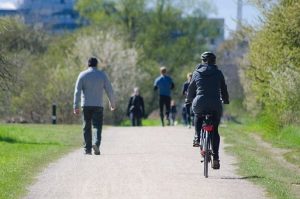Written by Joyce Smith, BS. Study results suggest that urban greening strategies should empathize the protection and restoration of urban tree canopies to promote community mental health.
 Previous studies have shown an association of green spaces with self-reported health quality, anxiety, and psychological stress 1. Recent studies have shown that the greening of vacant lots can decrease psychological stress and promote better mental health by reducing psychosomatic stress and increasing optimism 2. Green spaces increase social and physical recreation, provide natural, biodiverse soundscapes that are calming 3 and dampen chronic noise 4.
Previous studies have shown an association of green spaces with self-reported health quality, anxiety, and psychological stress 1. Recent studies have shown that the greening of vacant lots can decrease psychological stress and promote better mental health by reducing psychosomatic stress and increasing optimism 2. Green spaces increase social and physical recreation, provide natural, biodiverse soundscapes that are calming 3 and dampen chronic noise 4.
An observational study by Astell-Burt and colleagues 5 examined whether green space is associated with mental health. To that end they recruited 46,786 residentially stable, city dwellers from three Australian cities. Participant recruitment occurred from January 2006-December 2009 with a six-year follow-up from January, 2012 to December, 2015 and a final analysis in January of 2019. At baseline and at the six-year follow-up, researchers examined how living near different kinds of green space (including tree canopy, grass and low-lying vegetation) might be associated with three possible outcomes: the risk of psychological distress, self-reported physician-diagnosed depression or anxiety, and poor self-reported general health. Satellite imagery was used to calculate the percentage of total green space and types of green space such as tree canopies, grass and low-lying vegetation. Analysis adjusted for confounders such as age, sex, socioeconomic status, education and couple status. Multilevel models were used to simultaneously assess all three of the participating Australian cities.
Compared to men, women had a higher incidence of psychological distress (636 [3.7%] women vs 440 [2.8%] men) and physician-diagnosed depression or anxiety (1793 [8.9%] women vs 1139 [6.0%] men); however, men had a higher incidence of fair to poor general health compared to women (1502 [8.0%] men vs 1465 [6.7%] women). People with more total green space and more nearby tree canopy had better outcomes at baseline and follow-up even after adjusting for confounding in multilevel models. The prevalence and incidence of psychological distress and fair to poor general health was consistently associated with more nearby tree canopy exposure. For example, exposure to 30% or more tree canopy compared with 0% to 9% tree canopy was significantly associated with a 31% lower odds of psychological distress (OR 0.69; 95% CI, 0.54-0.88), self-rated fair to poor general health (OR 0.67; 95% CI, 0.57-0.80) and lower (but not significant) odds of depression or anxiety (OR 0.86; 95% CI, 0.74 to >1.00); whereas, exposure to 30% or more grass was associated with 71% higher odds of psychological distress after adjusting for age, sex, income, economic status, couple status, and educational level.
The research team recommends that since exposure to tree canopy was associated with a reduced incidence of psychological distress and improved self-rated general health, utilizing more tree canopies in urban greening strategies may be an effective option for mental health improvement in urban communities. Future studies are needed to determine whether tree canopy protection and restoration rather than urban greening, are a cost effective option for the promotion of community mental health.
Study limitations include potentially biased self-reported health outcomes, perhaps due to the stigma associated with mental health 6. Future studies should include prescription data and biomarkers of mental health. Also the fact that greenspace data available in 2016 may have decreased in some areas over time and that information on residence duration before baseline was not obtained may have led to an underestimation of true associations. The possibility of higher biodiversity levels rather than available green space in or near their areas of residence may also have impacted the psychological health of participants 3.
Source: Astell-Burt, Thomas, and Xiaoqi Feng. “Association of urban green space with mental health and general health among adults in Australia.” JAMA network open 2, no. 7 (2019): e198209-e198209.
Open Access: This is an open access article distributed under the terms of the CC-BY License. © 2019 Astell-Burt T et al. JAMA Network Open.
Click here to read the full text study.
Posted November 2, 2020.
Joyce Smith, BS, is a degreed laboratory technologist. She received her bachelor of arts with a major in Chemistry and a minor in Biology from the University of Saskatchewan and her internship through the University of Saskatchewan College of Medicine and the Royal University Hospital in Saskatoon, Saskatchewan. She currently resides in Bloomingdale, IL.
References:
- Gascon M, Triguero-Mas M, Martínez D, et al. Mental health benefits of long-term exposure to residential green and blue spaces: a systematic review. Int J Environ Res Public Health. 2015;12(4):4354-4379.
- Dzhambov AM, Markevych I, Hartig T, et al. Multiple pathways link urban green- and bluespace to mental health in young adults. Environ Res. 2018;166:223-233.
- Fuller RA, Irvine KN, Devine-Wright P, Warren PH, Gaston KJ. Psychological benefits of greenspace increase with biodiversity. Biology letters. 2007;3(4):390-394.
- Dzhambov AM, Dimitrova DD. Green spaces and environmental noise perception. Urban forestry & urban greening. 2015;14(4):1000-1008.
- Astell-Burt T, Feng X. Association of Urban Green Space With Mental Health and General Health Among Adults in Australia. JAMA Netw Open. 2019;2(7):e198209.
- Hatzenbuehler ML, Phelan JC, Link BG. Stigma as a fundamental cause of population health inequalities. Am J Public Health. 2013;103(5):813-821.
